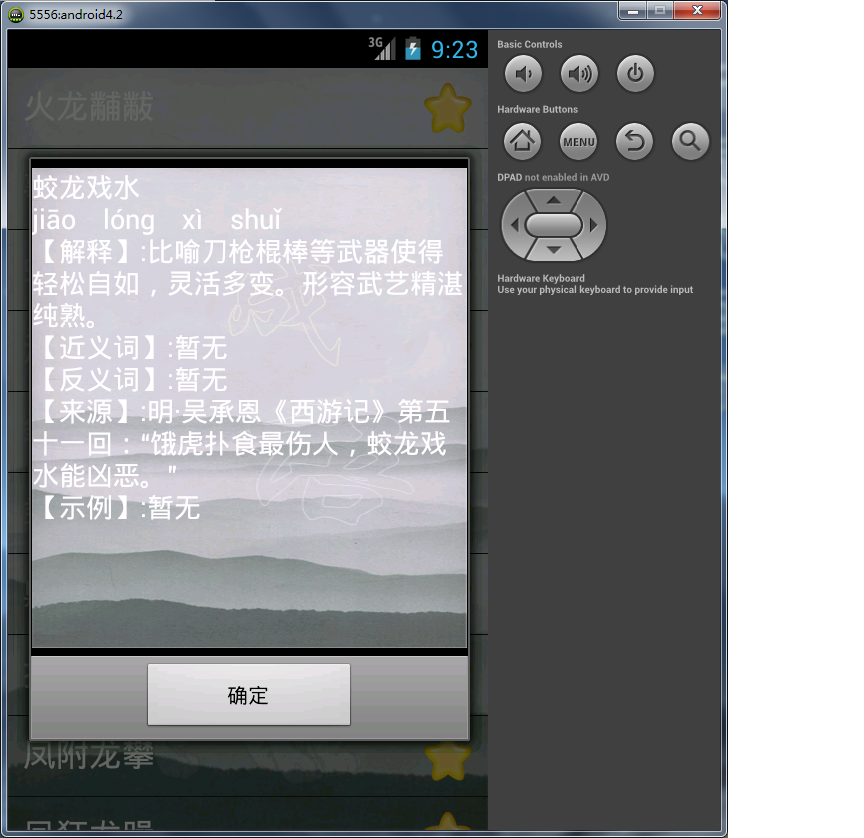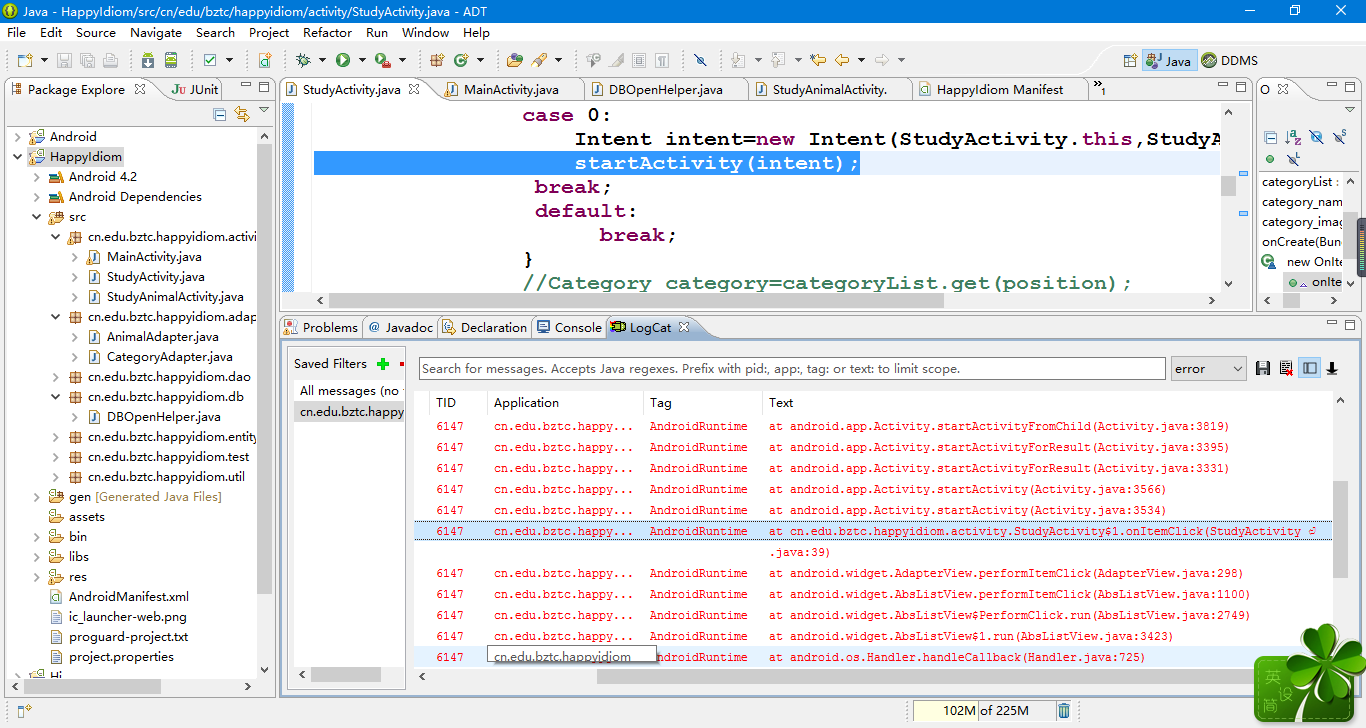由于本项目需要用到数据库,所以我们要先创建数据库。
然后,我们便要开始动手编代码了。首先我们要在项目下创建几个包,其中activity包用于存放所有相关活动的代码,db包用于存放数据库相关的代码,entity包用于存放所有实体相关的代码,dao包用于存放数据操作相关的代码,util包用于存放所有工具相关的代码。
我们还要在res目录下新建raw目录,将idioms.db数据库复制到此目录下。
首先,在db下新建一个DBOpenHelper类。实现将数据库文件从raw目录拷贝到手机存放数据库的位置。
package cn.edu.bztc.happyidiom.db;
import java.io.File;
import java.io.FileNotFoundException;
import java.io.FileOutputStream;
import java.io.IOException;
import java.io.InputStream;
import cn.edu.bztc.happyidiom.R;
import android.content.Context;
import android.database.sqlite.SQLiteDatabase;
import android.os.Environment;
import android.util.Log;
public class DBOpenHelper {
private final int BUFFER_SIZE = 400000;//缓冲区大小
public static final String DB_NAME = "idioms.db";//保存的数据库文件名
public static final String PACKAGE_NAME="cn.edu.bztc.happyidiom";//应用的包名
public static final String DB_PATH="/data"
+Environment.getDataDirectory().getAbsolutePath()+"/"
+PACKAGE_NAME+"/databases";//手机里存放数据库的位置
private Context context;
public DBOpenHelper(Context context){
this.context=context;
}
public SQLiteDatabase openDatabase(){
try{
File myDataPath = new File(DB_PATH);
if(!myDataPath.exists()){
myDataPath.mkdirs();//如果没有这个目录则创建
}
String dbfile = myDataPath+"/"+DB_NAME;
if(!(new File(dbfile).exists())){//判断数据库文件是否存在,若不存在则执行否则直接打开数据库
InputStream is = context.getResources().openRawResource(R.raw.idioms);
FileOutputStream fos = new FileOutputStream(dbfile);
byte[] buffer = new byte[BUFFER_SIZE];
int count = 0;
while ((count = is.read(buffer))>0){
fos.write(buffer,0, count);
}
fos.close();
is.close();
}
SQLiteDatabase db = SQLiteDatabase.openOrCreateDatabase(dbfile, null);
return db;
}catch(FileNotFoundException e){
Log.e("Database","File not found");
e.printStackTrace();
}catch(IOException e){
Log.e("Database","IO exception");
e.printStackTrace();
}
return null;
}
}
我们先开始搭建单元测试的环境,修改AndroidManifest.xml文件
<pre name="code" class="java"> <intent-filter>....<span style="font-family: Arial, Helvetica, sans-serif;"></intent-filter>中主要是注册了MainActivity,将其设为首先启动的类。</span><?xml version="1.0" encoding="utf-8"?>
<manifest xmlns:android="http://schemas.android.com/apk/res/android"
package="cn.edu.bztc.happyidiom"
android:versionCode="1"
android:versionName="1.0" >
<uses-sdk
android:minSdkVersion="14"
android:targetSdkVersion="18" />
<application
android:allowBackup="true"
android:icon="@drawable/ic_launcher"
android:label="@string/app_name"
android:theme="@android:style/Theme.NoTitleBar" >
<uses-library android:name="android.test.runner" />
<activity
android:name="cn.edu.bztc.happyidiom.activity.MainActivity"
android:label="@string/title_activity_main" >
<intent-filter>
<action android:name="android.intent.action.MAIN" />
<category android:name="android.intent.category.LAUNCHER" />
</intent-filter>
</activity>
<activity
android:name="cn.edu.bztc.happyidiom.activity.StudyActivity"
android:label="@string/title_activity_study" >
</activity>
<activity android:name="cn.edu.bztc.happyidiom.activity.StudyAnimalActivity">
</activity>
</application>
<instrumentation
android:name="android.test.InstrumentationTestRunner"
android:targetPackage="cn.edu.bztc.happyidiom" >
</instrumentation>
</manifest>//只封装了一个方法,该方法调用了DBOpenHelper类里面定义的openDatabase()方法
package cn.edu.bztc.happyidiom.test;
import cn.edu.bztc.happyidiom.db.DBOpenHelper;
import android.test.AndroidTestCase;
public class DBOpenHelperTest extends AndroidTestCase{
public void testDBCopy(){
DBOpenHelper dbOpenHelper=new DBOpenHelper(getContext());
dbOpenHelper.openDatabase();
}
}
然后再在entity包下新建一个Animal类<pre name="code" class="java">package cn.edu.bztc.happyidiom.entity;
public class Animal {
private int id;
private String name;//成语名称
private String pronounce;//成语发音
private String explain;//成语解释
private String antonym;//反义词
private String homoionym;//同义词
private String derivation;//源自
private String examples;//例子
public int getId() {
return id;
}
public void setId(int id) {
this.id = id;
}
public String getName() {
return name;
}
public void setName(String name) {
this.name = name;
}
public String getPronounce() {
return pronounce;
}
public void setPronounce(String pronounce) {
this.pronounce = pronounce;
}
public String getExplain() {
return explain;
}
public void setExplain(String explain) {
this.explain = explain;
}
public String getAntonym() {
return antonym;
}
public void setAntonym(String antonym) {
this.antonym = antonym;
}
public String getHomoionym() {
return homoionym;
}
public void setHomoionym(String homoionym) {
this.homoionym = homoionym;
}
public String getDerivation() {
return derivation;
}
public void setDerivation(String derivation) {
this.derivation = derivation;
}
public String getExamples() {
return examples;
}
public void setExamples(String examples) {
this.examples = examples;
}
}
package cn.edu.bztc.happyidiom.dao;
import java.util.ArrayList;
import java.util.List;
import cn.edu.bztc.happyidiom.db.DBOpenHelper;
import cn.edu.bztc.happyidiom.entity.Animal;
import android.content.Context;
import android.database.Cursor;
import android.database.sqlite.SQLiteDatabase;
public class AnimalDao {
private static AnimalDao animalDao;
private SQLiteDatabase db;
/**
* 将构造方法私有化
*/
private AnimalDao(Context context){
DBOpenHelper dbHelper = new DBOpenHelper(context);
db=dbHelper.openDatabase();
}
/**
* 获取AnimalDao的实例。
*/
public synchronized static AnimalDao getInstance(Context context){
if(animalDao==null){
animalDao = new AnimalDao(context);
}
return animalDao;
}
/**
* 从数据库读取所有的动物类成语。
*/
public List<Animal> getAllAnimals(){
List <Animal> list=new ArrayList<Animal>();
Cursor cursor = db.query("animal",null,null,null,null,null,null);
if(cursor.moveToFirst()){
do{
Animal animal = new Animal();
animal.setId(cursor.getInt(cursor.getColumnIndex("_id")));
animal.setName(cursor.getString(cursor.getColumnIndex("name")));
animal.setPronounce(cursor.getString(cursor.getColumnIndex("pronounce")));
animal.setExplain(cursor.getString(cursor.getColumnIndex("explain")));
animal.setAntonym(cursor.getString(cursor.getColumnIndex("antonym")));
animal.setHomoionym(cursor.getString(cursor.getColumnIndex("homoionym")));
animal.setDerivation(cursor.getString(cursor.getColumnIndex("derivation")));
animal.setExamples(cursor.getString(cursor.getColumnIndex("examples")));
list.add(animal);
}while(cursor.moveToNext());
}
return list;
}
}
package cn.edu.bztc.happyidiom.test;
import java.util.List;
import cn.edu.bztc.happyidiom.dao.AnimalDao;
import cn.edu.bztc.happyidiom.entity.Animal;
import android.test.AndroidTestCase;
public class AnimalDaoTest extends AndroidTestCase {
public void testGetAllAnimals(){
AnimalDao animalDao=AnimalDao.getInstance(getContext());
List <Animal> animals = animalDao.getAllAnimals();
System.out.println(animals.size());
for(Animal animal:animals){
System.out.println(animal.getName());
}
}
}<RelativeLayout xmlns:android="http://schemas.android.com/apk/res/android"
xmlns:tools="http://schemas.android.com/tools"
android:layout_width="match_parent"
android:layout_height="match_parent"
android:paddingBottom="@dimen/activity_vertical_margin"
android:paddingLeft="@dimen/activity_horizontal_margin"
android:paddingRight="@dimen/activity_horizontal_margin"
android:paddingTop="@dimen/activity_vertical_margin"
android:theme="@android:style/Theme.NoTitleBar"
tools:context=".MainActivity" >
<TabHost
android:id="@android:id/tabhost"
android:layout_width="match_parent"
android:layout_height="match_parent"
android:layout_alignParentLeft="true"
android:layout_alignParentTop="true" >
<LinearLayout
android:layout_width="match_parent"
android:layout_height="match_parent"
android:orientation="vertical"
>
<TabWidget
android:id="@android:id/tabs"
android:layout_width="match_parent"
android:layout_height="wrap_content">
</TabWidget>
<FrameLayout
android:id="@android:id/tabcontent"
android:layout_width="match_parent"
android:layout_height="match_parent">
<LinearLayout
android:id="@+id/tab1"
android:orientation="vertical"
android:layout_width="match_parent"
android:layout_height="match_parent">
</LinearLayout>
<LinearLayout
android:id="@+id/tab2"
android:orientation="vertical"
android:layout_width="match_parent"
android:layout_height="match_parent">
</LinearLayout>
<LinearLayout
android:id="@+id/tab3"
android:orientation="vertical"
android:layout_width="match_parent"
android:layout_height="match_parent">
</LinearLayout>
</FrameLayout>
</LinearLayout>
</TabHost>
</RelativeLayout><?xml version="1.0" encoding="utf-8"?>
<resources>
<string name="app_name">HappyIdiom</string>
<string name="action_settings">Settings</string>
<string name="hello_world">Hello world!</string>
<string name="title_activity_main">MainActivity</string>
<string name="title_study">学习</string>
<string name="title_search">搜搜</string>
<string name="title_game">游戏</string>
<string name="title_save">收藏</string>
<string name="title_help">帮助</string>
<string-array name="category">
<item>动物类</item>
<item>自然类</item>
<item>人物类</item>
<item>季节类</item>
<item>数字类</item>
<item>寓言类</item>
<item>其他类</item>
</string-array>
<string name="title_activity_study">StudyActivity</string>
</resources>/*
* 这个类中的onCreate()方法,通过调用getTabHost()方法来获取整个TabHost组件。
* 然后调用抽取出来的自定义方法addTab()添加了五个选项卡
*/
package cn.edu.bztc.happyidiom.activity;
import cn.edu.bztc.happyidiom.R;
import android.os.Bundle;
import android.app.TabActivity;
import android.content.Intent;
import android.view.Menu;
import android.view.Window;
import android.widget.TabHost;
@SuppressWarnings("deprecation")
public class MainActivity extends TabActivity {
private TabHost tabHost;
@Override
protected void onCreate(Bundle savedInstanceState) {
super.onCreate(savedInstanceState);
requestWindowFeature(Window.FEATURE_NO_TITLE);//取消标题栏
setContentView(R.layout.activity_main);
tabHost = getTabHost();
addTab("study",R.string.title_study,R.drawable.search,StudyActivity.class);
addTab("search",R.string.title_search,R.drawable.search,StudyActivity.class);
addTab("game",R.string.title_game,R.drawable.game,StudyActivity.class);
addTab("save",R.string.title_save,R.drawable.save,StudyActivity.class);
addTab("help",R.string.title_help,R.drawable.search,StudyActivity.class);
}
private void addTab(String tag, int title_introduction, int title_icon, Class ActivityClass){
// TODO Auto-generated method stub
tabHost.addTab(tabHost.newTabSpec(tag).setIndicator(getString(title_introduction),
getResources().getDrawable(title_icon)).setContent(new Intent(this,ActivityClass)));
}
@Override
public boolean onCreateOptionsMenu(Menu menu) {
// Inflate the menu; this adds items to the action bar if it is present.
getMenuInflater().inflate(R.menu.main, menu);
return true;
}
}package cn.edu.bztc.happyidiom.entity;
public class Category {
private String name;//类别名称
private int imageId;//类别对应的图片
public Category(String name,int imageId){
super();
this.name=name;
this.imageId=imageId;
}
public String getName(){
return name;
}
public int getImageId(){
return imageId;
}
}<RelativeLayout xmlns:android="http://schemas.android.com/apk/res/android"
xmlns:tools="http://schemas.android.com/tools"
android:layout_width="match_parent"
android:layout_height="match_parent"
android:paddingBottom="@dimen/activity_vertical_margin"
android:paddingLeft="@dimen/activity_horizontal_margin"
android:paddingRight="@dimen/activity_horizontal_margin"
android:paddingTop="@dimen/activity_vertical_margin"
android:background="@drawable/bg_ling"
tools:context=".StudyActivity">
<ListView
android:id="@+id/lvCategories"
android:layout_width="match_parent"
android:layout_height="wrap_content"
android:listSelector="#00000000"
android:layoutAnimation="@anim/anim_layout_listview"
android:layout_alignParentLeft="true"
android:layout_alignParentTop="true">
</ListView>
</RelativeLayout><?xml version="1.0" encoding="utf-8"?>
<LinearLayout xmlns:android="http://schemas.android.com/apk/res/android"
android:layout_width="match_parent"
android:layout_height="match_parent"
android:padding="10dp"
android:orientation="horizontal" >
<ImageView
android:id="@+id/category_image"
android:layout_width="wrap_content"
android:layout_height="wrap_content"
android:src="@drawable/category_animal"/>
<TextView
android:id="@+id/category_name"
android:layout_width="match_parent"
android:layout_height="wrap_content"
android:text="animal"
android:gravity="center"
android:textAppearance="?android:attr/textAppearanceLarge"/>
</LinearLayout>package cn.edu.bztc.happyidiom.adapter;
import java.util.List;
import cn.edu.bztc.happyidiom.entity.Category;
import cn.edu.bztc.happyidiom.R;
import android.content.Context;
import android.view.LayoutInflater;
import android.view.View;
import android.view.ViewGroup;
import android.widget.ArrayAdapter;
import android.widget.ImageView;
import android.widget.TextView;
public class CategoryAdapter extends ArrayAdapter<Category>{
private int resourceld;
public CategoryAdapter(Context context, int resource,
List<Category> objects) {
super(context, resource, objects);
// TODO Auto-generated constructor stub
resourceld=resource;
}
/*
* 我们可以在getView()中进行判断,如果convertView为空,则使用LayoutInflater
* 去加载布局,如果不为空则直接对convertView进行重用。
*/
public View getView(int position,View convertView,ViewGroup parent){
Category category=getItem(position);//获取当前项的Category实例
View view;
ViewHolder viewHolder;
if(convertView==null){
view = LayoutInflater.from(getContext()).inflate(resourceld,null);
viewHolder = new ViewHolder();
viewHolder.categoryImage=(ImageView)view.findViewById(R.id.category_image);
viewHolder.categoryName=(TextView)view.findViewById(R.id.category_name);
view.setTag(viewHolder);
}else{
view=convertView;
viewHolder=(ViewHolder)view.getTag();//重新获取ViewHolder
}
viewHolder.categoryImage.setImageResource(category.getImageId());
viewHolder.categoryName.setText(category.getName());
return view;
}
class ViewHolder{
ImageView categoryImage;
TextView categoryName;
}
/*ImageView categoryImage=(ImageView)view.findViewById(R.id.category_image);
TextView categoryName=(TextView)view.findViewById(R.id.category_name);
categoryImage.setImageResource(category.getImageId());
categoryName.setText(category.getName());
return view;*/
}
package cn.edu.bztc.happyidiom.activity;
import java.util.ArrayList;
import java.util.List;
import cn.edu.bztc.happyidiom.adapter.CategoryAdapter;
import cn.edu.bztc.happyidiom.entity.Category;
import cn.edu.bztc.happyidiom.R;
import android.os.Bundle;
import android.app.Activity;
import android.content.Intent;
import android.content.res.Resources;
import android.view.Menu;
import android.view.View;
import android.widget.AdapterView;
import android.widget.AdapterView.OnItemClickListener;
import android.widget.ListView;
public class StudyActivity extends Activity {
private List<Category>categoryList;
private String[] category_names;
private int[] category_images;
@Override
protected void onCreate(Bundle savedInstanceState) {
super.onCreate(savedInstanceState);
setContentView(R.layout.activity_study);
initCategories();//初始化类别
CategoryAdapter adapter=new CategoryAdapter(this,R.layout.category_item,categoryList);
ListView listView=(ListView) findViewById(R.id.lvCategories);
listView.setAdapter(adapter);
listView.setOnItemClickListener(new OnItemClickListener(){
@Override
public void onItemClick(AdapterView<?> adapterView, View view, int position,
long id) {
// TODO Auto-generated method stub
switch(position){
case 0:
Intent intent=new Intent(StudyActivity.this,StudyAnimalActivity.class);
startActivity(intent);
break;
default:
break;
}
//Category category=categoryList.get(position);
//Toast.makeText(StudyActivity.this, category.getName(), Toast.LENGTH_LONG).show();
}
});
}
private void initCategories() {
// TODO Auto-generated method stub
categoryList=new ArrayList<Category>();
Resources resources = getResources();
category_names=resources.getStringArray(R.array.category);
category_images=new int[]{R.drawable.category_animal,
R.drawable.category_nature,R.drawable.category_human,
R.drawable.category_season,R.drawable.category_number,
R.drawable.category_fable,R.drawable.category_other};
for(int i=0;i<category_names.length;i++){
categoryList.add(new Category(category_names[i],category_images[i]));
}
}
/*
* 这里添加了一个initCategories()方法,用于初始化所有的类别数据。并且在onCreate()方法中创建了CategoryAdapter对象,
* 把CategoryAdapter作为适配器传递给了ListView。
*/
@Override
public boolean onCreateOptionsMenu(Menu menu) {
// Inflate the menu; this adds items to the action bar if it is present.
getMenuInflater().inflate(R.menu.study, menu);
return true;
}
}
<?xml version="1.0" encoding="utf-8"?>
<alpha xmlns:android="http://schemas.android.com/apk/res/android"
android:duration="1000"
android:fromAlpha="0.0"
android:toAlpha="1.0">
</alpha><?xml version="1.0" encoding="utf-8"?>
<layoutAnimation xmlns:android="http://schemas.android.com/apk/res/android"
android:animation="@anim/anim_listview"
android:animationOrder="random"
android:delay="0.2">
</layoutAnimation><?xml version="1.0" encoding="utf-8"?>
<LinearLayout xmlns:android="http://schemas.android.com/apk/res/android"
android:layout_width="match_parent"
android:layout_height="match_parent"
android:background="@drawable/bg_animal"
android:orientation="vertical" >
<ListView
android:id="@+id/lvAnimalList"
android:layout_width="match_parent"
android:layout_height="wrap_content"
android:layoutAnimation="@anim/anim_layout_listview"
android:listSelector="#00000000">
</ListView>
</LinearLayout><?xml version="1.0" encoding="utf-8"?>
<RelativeLayout xmlns:android="http://schemas.android.com/apk/res/android"
android:layout_width="match_parent"
android:layout_height="match_parent"
android:padding="10dp">
<TextView
android:id="@+id/tvName"
android:layout_width="wrap_content"
android:layout_height="wrap_content"
android:layout_alignParentLeft="true"
android:layout_alignParentTop="true"
android:gravity="center"
android:text="助人为乐"
android:textAppearance="?android:attr/textAppearanceLarge"/>
<ImageButton
android:id="@+id/btnSave"
android:layout_width="wrap_content"
android:layout_height="wrap_content"
android:background="@null"
android:layout_alignParentRight="true"
android:layout_alignTop="@+id/tvName"
android:src="@drawable/btnsave"/>
</RelativeLayout>package cn.edu.bztc.happyidiom.adapter;
import java.util.List;
import cn.edu.bztc.happyidiom.entity.Animal;
import cn.edu.bztc.happyidiom.R;
import android.content.Context;
import android.view.LayoutInflater;
import android.view.View;
import android.view.View.OnClickListener;
import android.view.ViewGroup;
import android.widget.ArrayAdapter;
import android.widget.ImageButton;
import android.widget.TextView;
import android.widget.Toast;
public class AnimalAdapter extends ArrayAdapter<Animal>{
private int resourceld;
private Context context;
public AnimalAdapter(Context context, int resource,List<Animal>objects) {
super(context, resource,objects);
this.context=context;
resourceld = resource;
// TODO Auto-generated constructor stub
}
public View getView(int position,View convertView,ViewGroup parent){
final Animal animal=getItem(position);//获取当前项的Animal实例
View view;
ViewHolder viewHolder;
if(convertView ==null){
view=LayoutInflater.from(getContext()).inflate(resourceld, null);
viewHolder=new ViewHolder();
viewHolder.tvName=(TextView)view.findViewById(R.id.tvName);
viewHolder.btnSave=(ImageButton)view.findViewById(R.id.btnSave);
viewHolder.btnSave.setFocusable(false);
viewHolder.btnSave.setFocusableInTouchMode(false);
viewHolder.btnSave.setOnClickListener(new OnClickListener(){
public void onClick(View view){
Toast.makeText(context, "你要收藏"+animal.getName()+"吗",Toast.LENGTH_SHORT ).show();
}
});
view.setTag(viewHolder);
}else{
view=convertView;
viewHolder=(ViewHolder)view.getTag();
}
viewHolder.tvName.setText(animal.getName());
return view;
}
class ViewHolder{
TextView tvName;
ImageButton btnSave;
}
}package cn.edu.bztc.happyidiom.activity;
import java.util.List;
import cn.edu.bztc.happyidiom.adapter.AnimalAdapter;
import cn.edu.bztc.happyidiom.dao.AnimalDao;
import cn.edu.bztc.happyidiom.entity.Animal;
import cn.edu.bztc.happyidiom.util.DialogUtil;
import cn.edu.bztc.happyidiom.R;
import android.app.Activity;
import android.os.Bundle;
import android.view.View;
import android.widget.AdapterView;
import android.widget.AdapterView.OnItemClickListener;
import android.widget.ListView;
public class StudyAnimalActivity extends Activity{
private List<Animal>animalList;
private AnimalDao animalDao;
private ListView lvAnimalList;
protected void onCreate(Bundle savedInstanceState){
super.onCreate(savedInstanceState);
setContentView(R.layout.activity_animal);
initAnimals();
lvAnimalList=(ListView)findViewById(R.id.lvAnimalList);
AnimalAdapter animalAdapter=new AnimalAdapter(this,R.layout.animal_item,animalList);
lvAnimalList.setAdapter(animalAdapter);
lvAnimalList.setOnItemClickListener(new OnItemClickListener(){
@Override
public void onItemClick(AdapterView<?> adapterView, View view, int position,
long id) {
// TODO Auto-generated method stub
Animal animal=animalList.get(position);
String result=animal.getName()+"\n"+
animal.getPronounce()+
"\n【解释】:"+animal.getExplain()
+"\n【近义词】:"+animal.getHomoionym()+
"\n【反义词】:"+animal.getAntonym()+
"\n【来源】:"+animal.getDerivation()+
"\n【示例】:"+animal.getExamples();
DialogUtil.showDialog(result,StudyAnimalActivity.this);
}
});
}
private void initAnimals(){
animalDao=AnimalDao.getInstance(this);
animalList=animalDao.getAllAnimals();
}
}
<?xml version="1.0" encoding="utf-8"?>
<ScrollView xmlns:android="http://schemas.android.com/apk/res/android"
android:layout_width="match_parent"
android:layout_height="match_parent" >
<LinearLayout
android:layout_width="match_parent"
android:layout_height="match_parent"
android:background="@drawable/bg_ling"
android:orientation="vertical" >
<TextView
android:id="@+id/tvldiomInfo"
android:layout_width="match_parent"
android:layout_height="wrap_content"
android:text="Medium Text"
android:textAppearance="?android:attr/textAppearanceMedium"/>
</LinearLayout>
</ScrollView>package cn.edu.bztc.happyidiom.util;
import cn.edu.bztc.happyidiom.R;
import android.app.AlertDialog;
import android.content.Context;
import android.content.DialogInterface;
import android.view.LayoutInflater;
import android.view.View;
import android.widget.TextView;
public class DialogUtil {
public static void showDialog(String result,Context context) {
AlertDialog.Builder builder=new AlertDialog.Builder(context);
LayoutInflater layoutInflater=LayoutInflater.from(context);
View view=layoutInflater.inflate(R.layout.dialog_info, null);
builder.setView(view);
TextView tvldiomInfo=(TextView)view.findViewById(R.id.tvldiomInfo);
tvldiomInfo.setText(result);
builder.setPositiveButton("确定", new DialogInterface.OnClickListener() {
@Override
public void onClick(DialogInterface dialog, int which) {
// TODO Auto-generated method stub
dialog.dismiss();
}
});
builder.create().show();
}
}
结果图如下:
<img src="https://img-blog.csdn.net/20160613174136450" height="346" width="470" alt="" />
下面来说说我在做项目所遇到的情况:当我把代码打完后,出现如下图所示的错误,再点击动物类时显示错误。
显示我的StudyActivity类中的startActivity(intent)有错,经过检查是因为我的AndroidManifest.xml中忘记写上
<activity android:name="cn.edu.bztc.happyidiom.activity.StudyAnimalActivity">
</activity>























 289
289

 被折叠的 条评论
为什么被折叠?
被折叠的 条评论
为什么被折叠?








